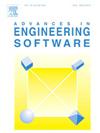一个开源的LS-DYNA实现的变分损伤模型
IF 4
2区 工程技术
Q2 COMPUTER SCIENCE, INTERDISCIPLINARY APPLICATIONS
引用次数: 0
摘要
在变分框架内制定的变分损伤模型(VDM)为断裂建模提供了一种有效且计算效率高的方法。然而,现有的实现方法主要依赖于定制开发的代码,这限制了其在工程应用中的可访问性和广泛采用。为解决这一局限性,本研究将新开发的变分损伤模型集成到商用有限元软件 LS-DYNA 中,使其在大规模模拟中得到实际应用。在 Ren 等人(2024 年)提出的 VDM 和新型变异损伤模型(NVDM)的基础上,本研究为 LS-DYNA 开发了用户自定义材料子程序(UMAT):(i)UMAT-VDM:变异损伤模型。(ii) UMAT-NVDM:包含阈值参数的增强型变异损伤模型。通过一系列准静态和动态断裂模拟评估了这些实现方法的有效性。结果表明,UMAT-VDM 和 UMAT-NVDM 都能准确捕捉到尖锐的裂纹界面,同时由于没有梯度项而保持了计算效率。此外,与 UMAT-VDM 相比,UMAT-NVDM 能生成更精细的裂纹模式,并在复杂断裂过程建模方面表现出更强的能力。为便于进一步研究和应用,这些子程序的开源实现采用自由格式的 FORTRAN90 语法编写,可在 GitHub 上公开获取,网址为 https://github.com/yaduann/vdm-and-nvdm。本文章由计算机程序翻译,如有差异,请以英文原文为准。
An open-source LS-DYNA implementation of the variational damage model
The variational damage model (VDM), formulated within a variational framework, provides an effective and computationally efficient approach to fracture modeling. However, existing implementations primarily rely on custom-developed codes, which limits their accessibility and broader adoption in engineering applications. To address this limitation, this study integrates newly developed variational damage models into the commercial finite element software LS-DYNA, enabling their practical use in large-scale simulations. Building upon the VDM and the novel variational damage model (NVDM) proposed by Ren et al. (2024), this work develops user-defined material subroutines (UMATs) for LS-DYNA: (i) UMAT-VDM: A variational damage model. (ii) UMAT-NVDM: An enhanced variational damage model incorporating a threshold parameter. The effectiveness of these implementations is assessed through a series of quasi-static and dynamic fracture simulations. The results demonstrate that both UMAT-VDM and UMAT-NVDM accurately capture sharp crack interfaces while maintaining computational efficiency due to the absence of gradient terms. Additionally, UMAT-NVDM produces finer crack patterns and exhibits improved capability in modeling complex fracture processes compared to UMAT-VDM. To facilitate further research and application, the open-source implementation of these subroutines, written in free-format FORTRAN90 syntax, is publicly available on GitHub at https://github.com/yaduann/vdm-and-nvdm.
求助全文
通过发布文献求助,成功后即可免费获取论文全文。
去求助
来源期刊

Advances in Engineering Software
工程技术-计算机:跨学科应用
CiteScore
7.70
自引率
4.20%
发文量
169
审稿时长
37 days
期刊介绍:
The objective of this journal is to communicate recent and projected advances in computer-based engineering techniques. The fields covered include mechanical, aerospace, civil and environmental engineering, with an emphasis on research and development leading to practical problem-solving.
The scope of the journal includes:
• Innovative computational strategies and numerical algorithms for large-scale engineering problems
• Analysis and simulation techniques and systems
• Model and mesh generation
• Control of the accuracy, stability and efficiency of computational process
• Exploitation of new computing environments (eg distributed hetergeneous and collaborative computing)
• Advanced visualization techniques, virtual environments and prototyping
• Applications of AI, knowledge-based systems, computational intelligence, including fuzzy logic, neural networks and evolutionary computations
• Application of object-oriented technology to engineering problems
• Intelligent human computer interfaces
• Design automation, multidisciplinary design and optimization
• CAD, CAE and integrated process and product development systems
• Quality and reliability.
 求助内容:
求助内容: 应助结果提醒方式:
应助结果提醒方式:


